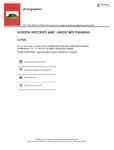HIDDEN HISTORIES AND LANDSCAPE ENIGMAS
| dc.contributor.author | Wells, Elizabeth Y | |
| dc.date.accessioned | 2019-06-27T11:53:18Z | |
| dc.date.available | 2019-06-27T11:53:18Z | |
| dc.date.issued | 2019-05-04 | |
| dc.identifier.issn | 1754-0763 | |
| dc.identifier.issn | 1754-0771 | |
| dc.identifier.uri | http://hdl.handle.net/10026.1/14478 | |
| dc.description.abstract |
Photographers investigate places, research detail and explore ways of conveying some sense of the atmosphere and significance of particular environments. Photographs reveal that which can be seen, their stillness inviting attention to detail that might otherwise be overlooked. Yet landscapes may offer few clues or traces of people and socio-political histories that characterize sites yet are not necessarily marked visually. Pictures evoke personal and cultural memory through suggesting experiences of place that transcend the limitations of visual documentation. Critically reflecting on photographic engagement with battlefields and sites of execution, this paper considers pictorial strategies intended to unearth hidden histories. It evaluates photo-methodologies and approaches to story-telling deployed by artist-photographers seeking to reveal historical sediments and, through referencing that which is known but may not be perceived, to invoke reflection on legacies of conflict. Examples include: Bleda y Rosa, Battlefields; Chloe Dewe Matthews, Shot at Dawn; David Farrell, Innocent Landscapes; Ori Gersht, The Clearing; Anthony Haughey, Disputed Territory; Bart Michiels, The Course of History. It is suggested that, despite ways in which vistas veil histories and photographs prioritize the visible, through the inter-relation of research, reflection and aesthetic tactics photography can suggest hidden histories and offer insights into landscape enigmas. | |
| dc.format.extent | 177-193 | |
| dc.language | en | |
| dc.language.iso | en | |
| dc.publisher | Informa UK Limited | |
| dc.title | HIDDEN HISTORIES AND LANDSCAPE ENIGMAS | |
| dc.type | journal-article | |
| dc.type | Journal Article | |
| plymouth.issue | 2 | |
| plymouth.volume | 12 | |
| plymouth.publication-status | Published | |
| plymouth.journal | photographies | |
| dc.identifier.doi | 10.1080/17540763.2019.1582434 | |
| plymouth.organisational-group | /Plymouth | |
| plymouth.organisational-group | /Plymouth/Faculty of Arts, Humanities and Business | |
| plymouth.organisational-group | /Plymouth/Users by role | |
| dc.identifier.eissn | 1754-0771 | |
| dc.rights.embargoperiod | Not known | |
| rioxxterms.versionofrecord | 10.1080/17540763.2019.1582434 | |
| rioxxterms.licenseref.uri | http://www.rioxx.net/licenses/all-rights-reserved | |
| rioxxterms.type | Journal Article/Review |


